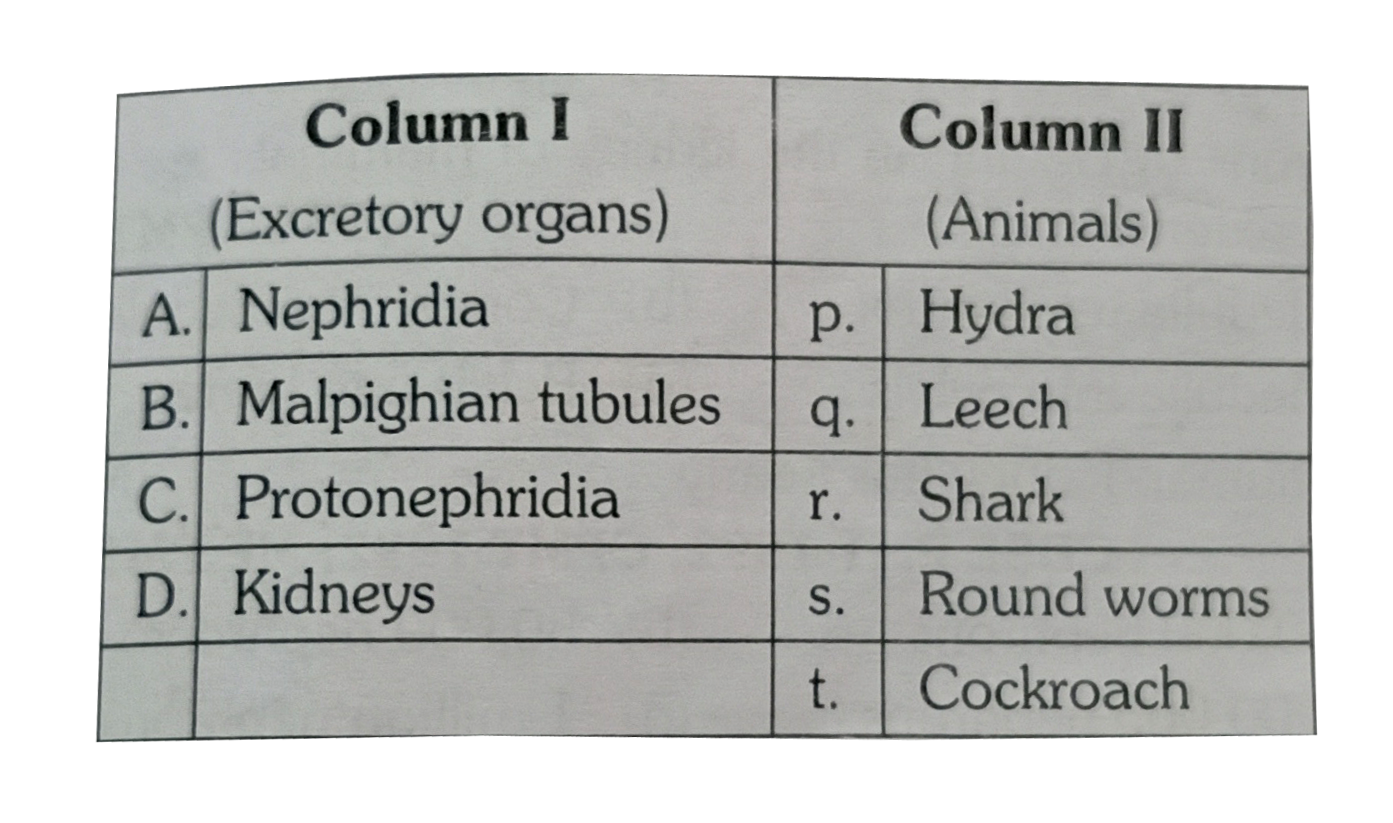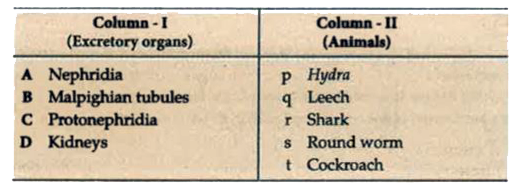Sort and list the animals given below in the correct columns.
Polar Bear, Asian Elephant, Orangutan, Blue Whale, Black Rhino, Hawksbill Turtle

Topper's Solved these Questions
- BOOK - PEARSON IIT JEE FOUNDATIONCHAPTER - CONSERVATION OF PLANTS AND ANIMALSEXERCISE - CLASSROOM CORNER (C. LONG ANSWER TYPE QUESTIONS )9videos
CONSERVATION OF PLANTS AND ANIMALS
- BOOK - PEARSON IIT JEE FOUNDATIONCHAPTER - CONSERVATION OF PLANTS AND ANIMALSEXERCISE - COMPETITION CORNER43videos
CONSERVATION OF PLANTS AND ANIMALS
- BOOK - PEARSON IIT JEE FOUNDATIONCHAPTER - CONSERVATION OF PLANTS AND ANIMALSEXERCISE - CLASSROOM CORNER (A. VERY SHORT ANSWER TYPE QUESTIONS) (SUBJECTIVE TYPE QUESTIONS )20videos
CONSERVATION OF PLANTS AND ANIMALS
- BOOK - PEARSON IIT JEE FOUNDATIONCHAPTER - CELL-STRUCTURE AND FUNCTIONSEXERCISE - Competition Corner (M.C.Q)49videos
CELL-STRUCTURE AND FUNCTIONS
- BOOK - PEARSON IIT JEE FOUNDATIONCHAPTER - CROP PRODUCTION AND MANAGEMENT EXERCISE - COMPETITIONS CORNER44videos
CROP PRODUCTION AND MANAGEMENT
Similar Questions
Match column -I with column -II and select the correct answer using the codes given below in the listes (n,l and m are respectively the principla azimuthal and magnetic quantum no .)
column−Icolumn-II(a)number of values of l for the an energy level(n)(p)0.1.2.....(n−1)(b)values of l for a particular type of orbit (q)+lto -l therpough zero(c)Number of values of m for l=2 (r)5(d)values of m (s)nView SolutionComplete the paragraph given below by filling in the blanks choosing the correct option from those that follow-
Elephants (a) _____ the largest land mammals. Three species of elephants (b) _____ living today. Elephants (c) ________other Elephantidae were once classified with other thick skinned . The elephant’s gestation period is 22 months, (d) _________ longest for any land animal.View Solution
Knowledge Check
- Question 1 - Select One
Match the excretory organs listed under column I with the animals given under column. II Choose answer which gives the correct combination of alphabets of the two
 AA=q, B=t, C=s, D=rBA=s, B=q, C=p, D=tCA=t, B=q, C=s, D=rDA=q, B=s, C=t, D=p
AA=q, B=t, C=s, D=rBA=s, B=q, C=p, D=tCA=t, B=q, C=s, D=rDA=q, B=s, C=t, D=p - Question 2 - Select One
Match the excretory organs listed under column I with the animals given under column II. Choose the answer which gives the correct combination of alphabets of two columns.
 AA=t,B=q,C=s,D=rBA=q,B=s,C=t,D=pCA=q,B=t,C=s,D=rDA=s,B=q,C=p,D=t
AA=t,B=q,C=s,D=rBA=q,B=s,C=t,D=pCA=q,B=t,C=s,D=rDA=s,B=q,C=p,D=t - Question 3 - Select One
Match the four starting materials given is Column I with the corresponding reaction schemes provided in Column II and select the correct anwer using the code given below the lists
 AABCDpqrsBABCDrpsqCABCDrsqpDABCDsprq
AABCDpqrsBABCDrpsqCABCDrsqpDABCDsprq
Complete the paragraph given below by filling in the blanks choosing the correct option from those that follow-
Elephants (a) _____ the largest land mammals. Three species of elephants (b) _____ living today. Elephants (c) ________other Elephantidae were once classified with other thick skinned . The elephant’s gestation period is 22 months, (d) _________ longest for any land animal.View SolutionComplete the paragraph given below by filling in the blanks choosing the correct option from those that follow-
Elephants (a) _____ the largest land mammals. Three species of elephants (b) _____ living today. Elephants (c) ________other Elephantidae were once classified with other thick skinned . The elephant’s gestation period is 22 months, (d) _________ longest for any land animal.View SolutionComplete the paragraph given below by filling in the blanks choosing the correct option from those that follow-
Elephants (a) _____ the largest land mammals. Three species of elephants (b) _____ living today. Elephants (c) ________other Elephantidae were once classified with other thick skinned . The elephant’s gestation period is 22 months, (d) _________ longest for any land animal.View SolutionRead the passage given below and answer the questions by choosing the correct alternative that follow. The saving of certain wild animals from extinction has for many years been a problem for zoologists and other specialists, but more recently the problem has become so acute, and has received so much publicity, that most people are now concerned about it. This may at first seem strange because onc of the most gratifying developments of the last few years has been the passing of strict laws to protect wild animals and the consequent decline in the hunting of big-game for sport. Why is it, then that some rare wild animals are still threatened with extinction and even some of the less rare ones are rapidly declining in number? One reason is the 'march of civilization. When an area is wholly cleared of vegetation to make room for new towns, factory sites or hydroelectric plants, the natural home of several species is destroyed. The displaced animals must either migrate to another area or perish. Even the clearing of land for a road or an airfield may involve 'pushing back the jungle and the small area in which wild animals compete for a living, the smaller the number that can hope to survive. Civilization brings too, swift and easy transport and so assists those who are determined to break the various protective laws. Thieves can elude the game wardens, shoot an elephant for its tusks, a rhinoceros for its horn or a deer for its meat and be miles away from the site of the crime before the dead or dying victim is even discovered It is sad to reflect that civilization which can bring so many benefits to people who have previously known only hunger and misery, brings also facilities for the heartless criminals who, for material gain, will slaughter some harmless animals and threaten the disappearance of its kind from the earth forever.
How does modern transport threaten the survival of wild animals?View SolutionRead the passage given below and answer the questions by choosing the correct alternative that follow. The saving of certain wild animals from extinction has for many years been a problem for zoologists and other specialists, but more recently the problem has become so acute, and has received so much publicity, that most people are now concerned about it. This may at first seem strange because onc of the most gratifying developments of the last few years has been the passing of strict laws to protect wild animals and the consequent decline in the hunting of big-game for sport. Why is it, then that some rare wild animals are still threatened with extinction and even some of the less rare ones are rapidly declining in number? One reason is the 'march of civilization. When an area is wholly cleared of vegetation to make room for new towns, factory sites or hydroelectric plants, the natural home of several species is destroyed. The displaced animals must either migrate to another area or perish. Even the clearing of land for a road or an airfield may involve 'pushing back the jungle and the small area in which wild animals compete for a living, the smaller the number that can hope to survive. Civilization brings too, swift and easy transport and so assists those who are determined to break the various protective laws. Thieves can elude the game wardens, shoot an elephant for its tusks, a rhinoceros for its horn or a deer for its meat and be miles away from the site of the crime before the dead or dying victim is even discovered It is sad to reflect that civilization which can bring so many benefits to people who have previously known only hunger and misery, brings also facilities for the heartless criminals who, for material gain, will slaughter some harmless animals and threaten the disappearance of its kind from the earth forever.
How is the natural home of several species of animals destroyed?View Solution

